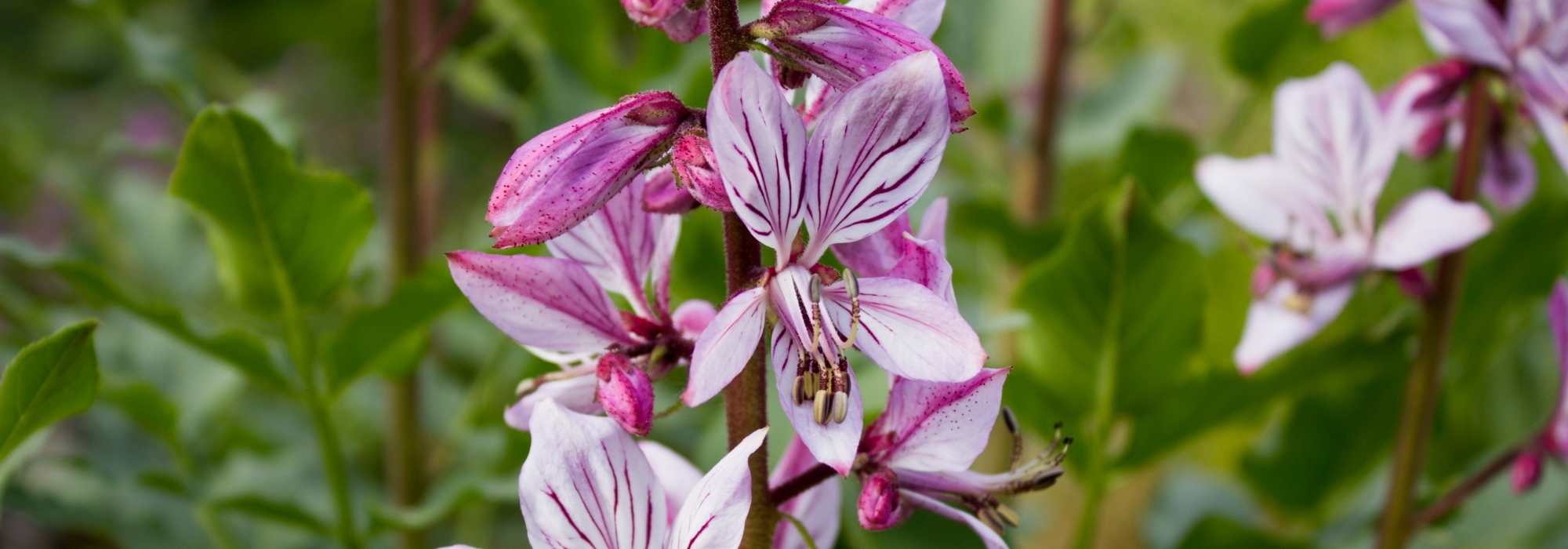
Dictamnus, Fraxinelle: planting and caring for it
Contents
Dictamnus in a nutshell
- White dictamnus is a perennial plant that flowers in summer
- Fraxinet is very hardy and highly drought-resistant
- Plant it in full sun!
- Any well-drained soil suits it, even stony, calcareous, and poor
- Dictamnus albus is a native species that feeds many insects
The word from our expert
The Dictamnus albus has two astonishing characteristics. The first is that it has more different names than a character in a J.R.R. Tolkien novel: Fraxinelle, white Fraxinelle, little ash, white dictam, shop dictam, and even gas plant or burning bush. The second, and you will understand these last two nicknames shortly, is that it has the ability to produce volatile substances that ignite quickly upon contact with a spark or simply in very hot weather. However, there’s no need to worry for your garden; these flames appear very briefly, posing no risk to its foliage or the surrounding vegetation.
But the fraxinelle is above all a stunning plant thanks to its aromatic foliage, somewhat reminiscent of that of the ash tree, and especially its summer flowering in panicles of numerous small star-shaped flowers: pale pink veined with dark pink for the typical species, a deeper pink for the ‘Purpureus’ form, or even white for the ‘Albiflorus’ variety. These flowers are both fragrant, nectariferous, and melliferous.
It is a native plant that is not uncommon to encounter in the East and South of France. The white dictam enjoys full sun and thrives wonderfully in dry conditions. Very hardy, this charming perennial will be content with neutral to calcareous, stony, and even poor soil. Ideal therefore in a sunny rockery or within a sparse area of native plants (biodiversity hotspot). Its only two requirements are to grow in very well-drained soil and… to be left alone, as it dislikes being moved.
In short, if you are looking for a beautiful European perennial that is low-maintenance and beneficial to wildlife: consider the fraxinelle!
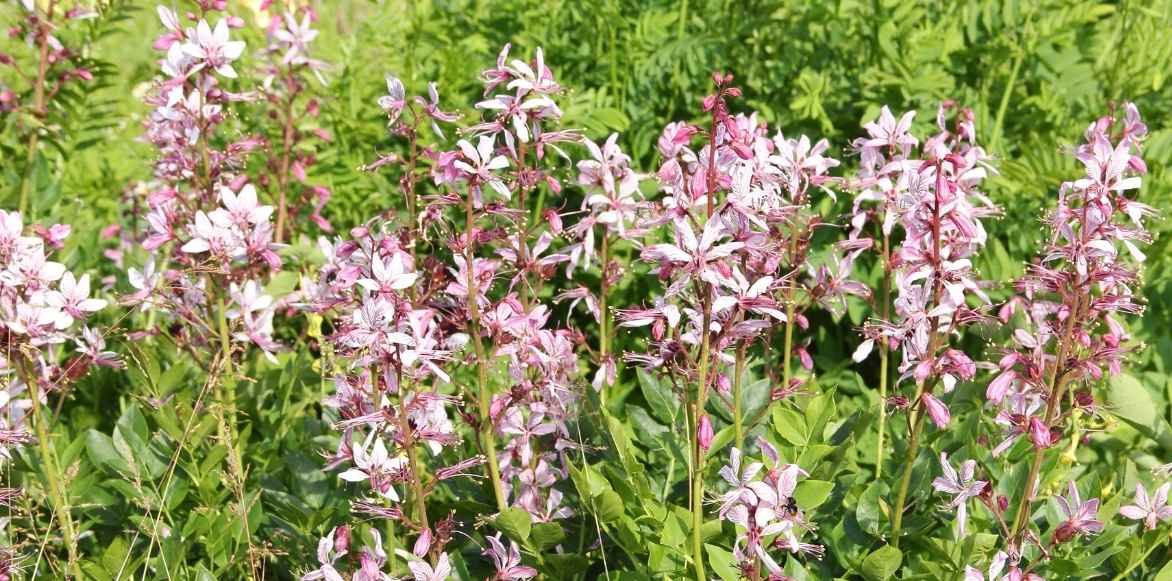 The fraxinelle: a very beautiful summer flowering for the garden!
The fraxinelle: a very beautiful summer flowering for the garden!
Botany and description
Botanical data
- Latin name Dictamnus albus
- Family Rutaceae
- Common name Fraxinelle, Burning bush, Dictame des boutiques
- Flowering May to July
- Height 0.60 to 1.20 m
- Sun exposure sun
- Soil type poor, even alkaline, drained and dry
- Hardiness -15°C
The genus Dictamnus contains only one species: Dictamnus albus. This plant belongs to the Rutaceae family, which includes citrus trees and other ornamental plants like the Mexican Orange. Dictamnus albus is a perennial plant with a wide natural distribution: southern, central, and eastern Europe, as well as central Asia up to southern Siberia and North Africa. In France, it can even be found in Alsace, Ariège, Savoie, Isère, Gard, Hérault, and Provence. It typically grows in open areas near wooded zones: clearings and limestone slopes, as well as undergrowth and clear deciduous forests.
Its common name is Fraxinelle, White Fraxinelle, Little Ash, or Dictame blanc or Dictame des boutiques. The plant is sometimes also called “Burning bush” or “Gas plant” due to the sticky, fragrant substance (lemon scent) that is especially flammable when exposed to a flame or simply in high heat. However, there is no need for concern, as these volatile essential oils “ignite” too briefly to set fire to other plants or even its own foliage.
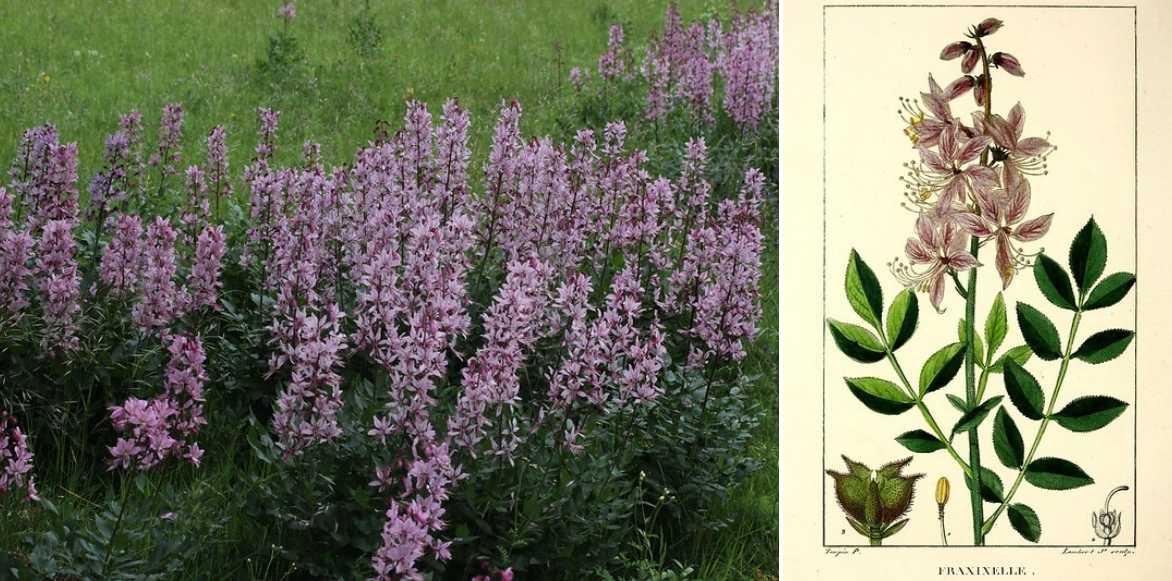
Dictamnus albus (© Björn S), and botanical plate (circa 1830)
The plant should not be confused with the Cretan Dictamnus or Origanum dictamnus.
The stump is thick, white (hence the species name “Albus“) and running. The root system is highly ramified. The stems are reddish and covered with red glandular hairs. It is these glands that produce the volatile and flammable substances. The dictame is a tufted perennial. Although very hardy, it enjoys warmth.
The leaf is compound and odd-pinnate (with an odd number of leaflets) with 7 or 9 ovate leaflets, resembling that of an ash tree. The foliage of the fraxinelle is deciduous, leathery, and a fresh, bright green colour. The foliage is aromatic and releases notes of citrus and cinnamon.
The inflorescence is a loose panicle composed of small flowers with 5 petals and 10 long stamens. The flowers are white to pale pink, but veined with dark pink. The form Dictamnus albus var. purpureus (sometimes referred to as Dictamnus albus var. Dictamnus rubra) features flowers of a deeper pink, while the variety ‘Albiflorus’ boasts white flowers. The flower buds are purple.
The fruits are dehiscent capsules (which open on their own when mature). The black, shiny seeds are projected into the air. They have ridges that dry out to form a sort of spring that propels the seed even further.
The flowers of Dictamnus albus are fragrant, as well as melliferous and nectariferous. They attract and nourish a wide range of insects: bees, bumblebees, butterflies, hoverflies…
Dictamnus albus is a protected species in France since 1994. In the wild, it is strictly forbidden to “destroy, cut, mutilate, uproot, pick or remove, trade, use, sell, or buy any part of wild specimens”.
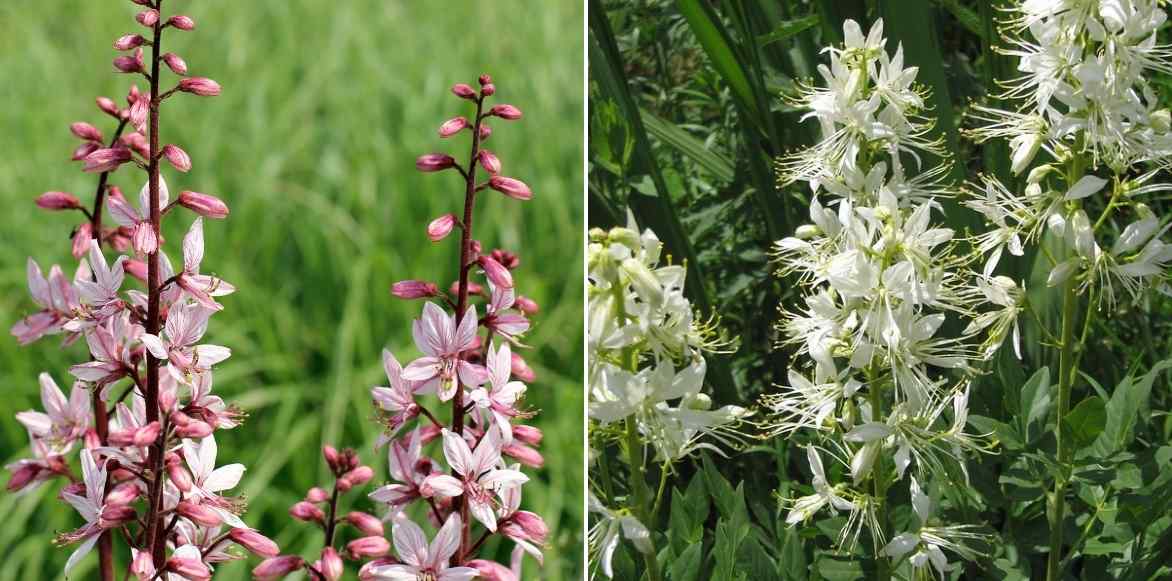
Pink and white flowering of fraxinelles (photo on the right © Peganum)
Our varieties of Ash trees
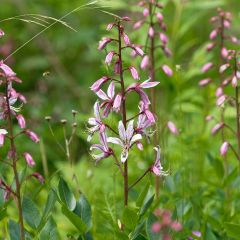
Dictamnus albus - Dittany
- Période de floraison July, August
- Hauteur à maturité 60 cm
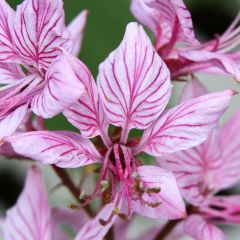
Dictamnus albus var. purpureus - Dittany
- Période de floraison July, August
- Hauteur à maturité 60 cm
How to plant a common rue?
Where to plant?
Fraxinella should be planted in full sun or, at a pinch, in light partial shade.
Although perfectly hardy, this perennial particularly enjoys warmth and can withstand dry spells without complaint: it is said to be thermophilic. It thrives in stony soils, even calcareous and poor ones. It absolutely requires well-drained soil. It is the ideal host for a dry rockery in full sun, for example.
When to plant?
Planting should preferably be done from late March to May. In any case, avoid planting during frost or periods of severe drought.
How to plant?
- Soak the root ball in water for a few minutes;
- Remove from the pot, check the roots, and gently untangle them if necessary;
- Dig a hole twice as wide and twice as deep as the root ball of your plant;
- Loosen the soil at the bottom of the hole;
- Add a bit of sand or small gravel if your soil is too heavy;
- Add well-matured compost;
- Place the root ball at the bottom of the hole;
- Backfill the hole and firm the soil around the plant with your hands;
- Water generously to eliminate any “air pockets” between the soil and the roots.
Be sure not to bury the collar of your dictamnus! Leave 60 cm between each fraxinella plant.
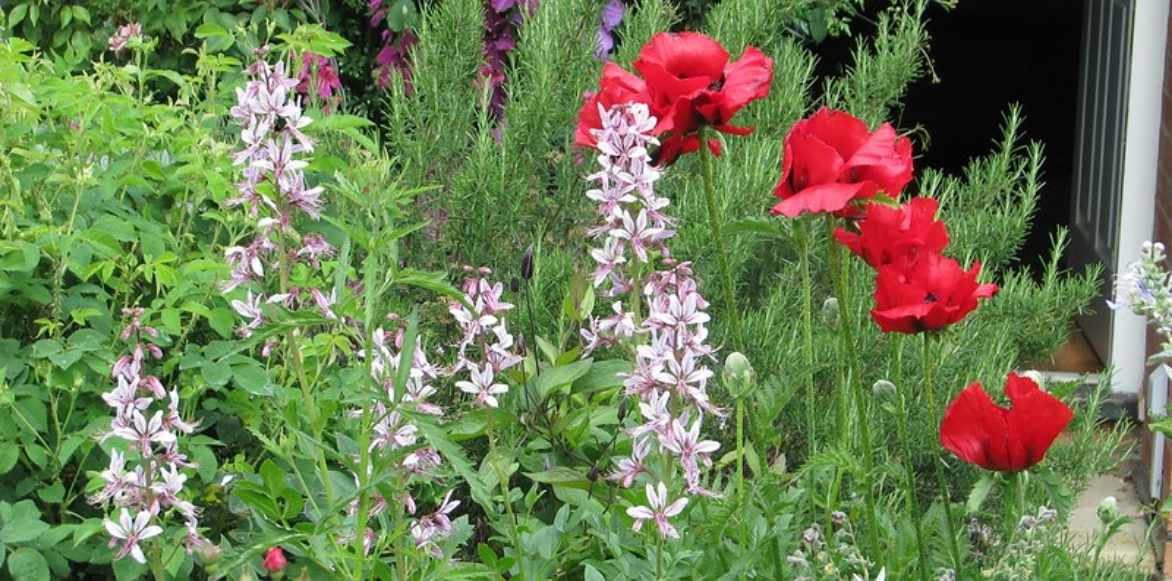
A lovely bed of Dictamnus, poppies, and rosemary (© Peganum)
Read also
5 perennials for dry groundCare for Ash Trees
No special maintenance or care is required. Just cut the flower spikes once they have faded, but this will prevent you from obtaining spontaneous sowing.
A small detail of importance: the plant disappears in winter. So do not hesitate to mark its location to avoid inadvertently giving it a good whack with a spade.
The rue is of rapid growth, but paradoxically it takes a long time to establish: at least 10 years. Therefore, it is a plant that requires patience. Furthermore, the ramified root system does not allow for easy relocation of the plant: so choose its location wisely!
Diseases and Pests of Dictamnus albus
This will be very brief: no disease or pest is to be feared for your ash tree.
How to propagate rue?
Forget about any potential stump division, as the root system of the plant cannot withstand being disturbed: do not divide your dictamnus and do not attempt to move it!
However, sowing is entirely possible: in a very well-draining substrate, or even pure sand, sow seeds collected at the end of summer in a seed tray. Place this tray outside, in partial shade, and keep the substrate moist. You will need patience: the seeds only germinate after 15 to 20 weeks.
Associate the Dictamnus
The fraxinelle is a sun-loving plant that thrives in poor soil. The idea is to create a mineral bed, but with plants native to our region, thus adapted to the climate and especially beneficial for small wildlife. It is essential to choose plants that prefer poor, calcareous, well-drained soils and that enjoy heat while tolerating drought. This is entirely possible! Here is a short list of such perennials: Asparagus acutifolius or Wild Asparagus, Iris lutescens or Dwarf Iris, Cyanus montanus or Mountain Centaury, Helichrysum italicum or Curry Plant, Catananche caerulea or Cupidone, Achillea tomentosa, Eryngium alpinum, Digitalis lutea, Campanula persicifolia, and a mullein or Verbascum nigrum. And, of course, a lovely Dictamnus albus var. purpureus.
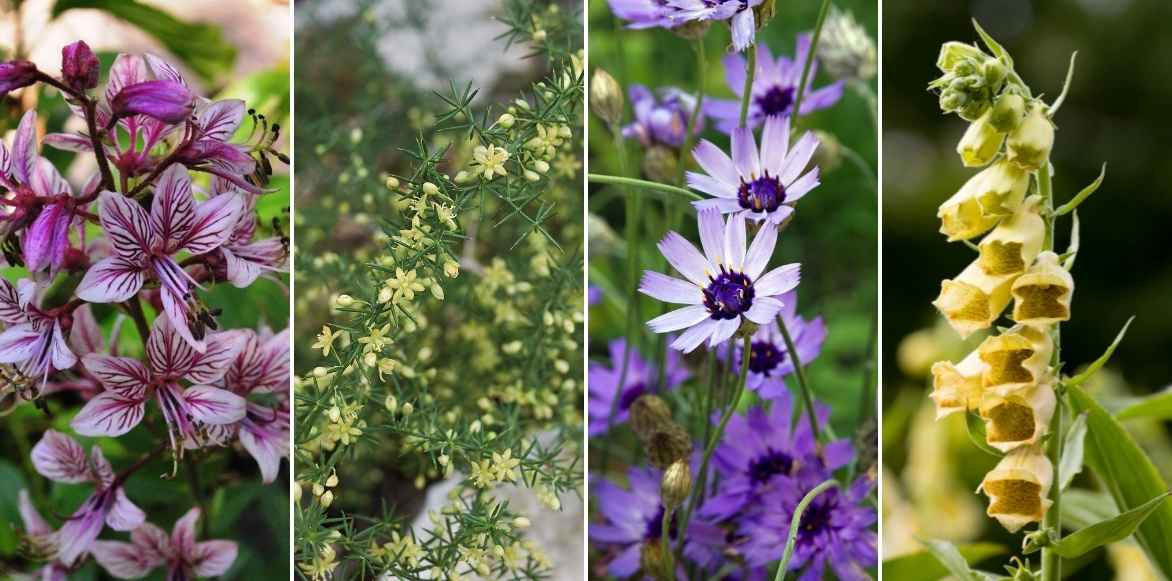
Dictamnus albus var. purpureus, Asparagus acutifolius, Catananche caerulea, and Digitalis lutea are perfect companions for sunny, dry soils.
Please note: paradoxically, the poorer the soil, the greater the botanical (and resulting faunal) diversity will be. Therefore, it is possible to recreate on small areas (just a few square metres) lean zones, hotspots of biodiversity. Simply remove the fertile topsoil to about 30 cm, then fill the “hole” with sand, gravel, and rubble. Afterwards, you can sow seeds of annuals and biennials of native flowers and plant a few perennials from your region or… simply let Nature take its course. The Dictamnus albus will thrive in this lean area.
→ To learn more, feel free to check out the Hortus-France.org website.
Did you know?
- The Dictamnus albus can sometimes serve as a host plant for the swallowtail caterpillar (Papilio machaon);
- In the 18th century, Abbé Pierre-Nicolas Bertholon de Saint-Lazare, a French physicist, conducted research on the fraxinelle. In the mountains, he brought a static electricity generator. In a dark room, he then brought sparks generated by the electric generator very close to the stamens. The volatile substances ignited, producing a bright light;
- Linnaeus named this plant “Dictamnus” due to the aromatic similarity of its foliage with Origanum dictamnus, the herb of Mount Dikté;
- The species name “albus”, meaning white, refers to the colour of its root and not to that of its flowers;
- The white dictamnus shares the nickname “burning bush” with a bush: Pyracantha;
- It is quite likely that the burning bush described in the Bible is a Dictamnus albus;
- It is said that Carl von Linné’s daughter invented the name “Gas Plant“;
- The common name “Fraxinelle” comes from the similarity of its leaves to those of the Ash (Fraxinus excelsior);
- In antiquity, the fraxinelle was known for its medicinal virtues. It was used in the treatment of various ailments: for hysteria and epilepsy, to combat fever and symptoms of plague with the root of the plant ground into powder; the sticky, fragrant, and flammable substance as an anti-inflammatory; and the aerial parts (leaves and stems) as a diuretic;
- Today, although recognised for its beneficial action on the stomach, the plant is no longer used except as an infusion of leaves to combat nervousness and anxiety;
- Prolonged contact with the plant can cause dermatitis;
- The fraxinelle was once used in the perfume industry for its citrus fragrances.
- Subscribe!
- Contents































Comments